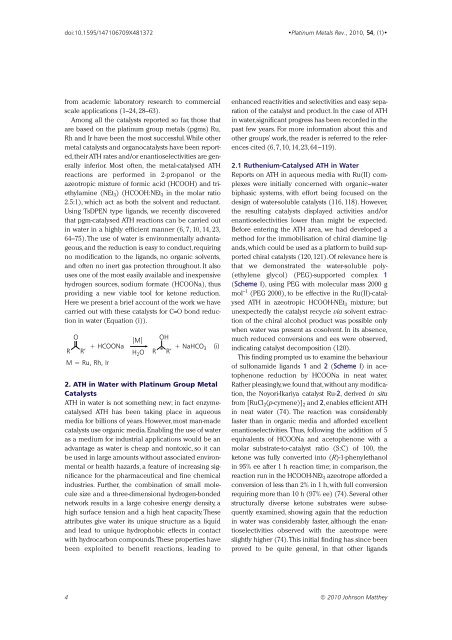Download Issue PDF - Platinum Metals Review
Download Issue PDF - Platinum Metals Review
Download Issue PDF - Platinum Metals Review
You also want an ePaper? Increase the reach of your titles
YUMPU automatically turns print PDFs into web optimized ePapers that Google loves.
doi:10.1595/147106709X481372<br />
•<strong>Platinum</strong> <strong>Metals</strong> Rev., 2010, 54, (1)•<br />
from academic laboratory research to commercial<br />
scale applications (1–24, 28–63).<br />
Among all the catalysts reported so far, those that<br />
are based on the platinum group metals (pgms) Ru,<br />
Rh and Ir have been the most successful.While other<br />
metal catalysts and organocatalysts have been reported,their<br />
ATH rates and/or enantioselectivities are generally<br />
inferior. Most often, the metal-catalysed ATH<br />
reactions are performed in 2-propanol or the<br />
azeotropic mixture of formic acid (HCOOH) and triethylamine<br />
(NEt 3 ) (HCOOH:NEt 3 in the molar ratio<br />
2.5:1), which act as both the solvent and reductant.<br />
Using TsDPEN type ligands, we recently discovered<br />
that pgm-catalysed ATH reactions can be carried out<br />
in water in a highly efficient manner (6, 7, 10, 14, 23,<br />
64–75). The use of water is environmentally advantageous,and<br />
the reduction is easy to conduct,requiring<br />
no modification to the ligands, no organic solvents,<br />
and often no inert gas protection throughout. It also<br />
uses one of the most easily available and inexpensive<br />
hydrogen sources, sodium formate (HCOONa), thus<br />
providing a new viable tool for ketone reduction.<br />
Here we present a brief account of the work we have<br />
carried out with these catalysts for C=O bond reduction<br />
in water (Equation (i)).<br />
O<br />
R R’<br />
+ HCOONa<br />
M = Ru, Rh, Ir<br />
[M]<br />
H 2 O<br />
OH<br />
R<br />
+ NaHCO<br />
*<br />
3<br />
R’<br />
(i)<br />
2. ATH in Water with <strong>Platinum</strong> Group Metal<br />
Catalysts<br />
ATH in water is not something new; in fact enzymecatalysed<br />
ATH has been taking place in aqueous<br />
media for billions of years. However, most man-made<br />
catalysts use organic media.Enabling the use of water<br />
as a medium for industrial applications would be an<br />
advantage as water is cheap and nontoxic, so it can<br />
be used in large amounts without associated environmental<br />
or health hazards, a feature of increasing significance<br />
for the pharmaceutical and fine chemical<br />
industries. Further, the combination of small molecule<br />
size and a three-dimensional hydrogen-bonded<br />
network results in a large cohesive energy density, a<br />
high surface tension and a high heat capacity. These<br />
attributes give water its unique structure as a liquid<br />
and lead to unique hydrophobic effects in contact<br />
with hydrocarbon compounds.These properties have<br />
been exploited to benefit reactions, leading to<br />
enhanced reactivities and selectivities and easy separation<br />
of the catalyst and product. In the case of ATH<br />
in water,significant progress has been recorded in the<br />
past few years. For more information about this and<br />
other groups’ work, the reader is referred to the references<br />
cited (6, 7, 10, 14, 23, 64 –119).<br />
2.1 Ruthenium-Catalysed ATH in Water<br />
Reports on ATH in aqueous media with Ru(II) complexes<br />
were initially concerned with organic–water<br />
biphasic systems, with effort being focused on the<br />
design of water-soluble catalysts (116, 118). However,<br />
the resulting catalysts displayed activities and/or<br />
enantioselectivities lower than might be expected.<br />
Before entering the ATH area, we had developed a<br />
method for the immobilisation of chiral diamine ligands,which<br />
could be used as a platform to build supported<br />
chiral catalysts (120,121).Of relevance here is<br />
that we demonstrated the water-soluble poly-<br />
(ethylene glycol) (PEG)-supported complex 1<br />
(Scheme I), using PEG with molecular mass 2000 g<br />
mol –1 (PEG 2000), to be effective in the Ru(II)-catalysed<br />
ATH in azeotropic HCOOH-NEt 3 mixture; but<br />
unexpectedly the catalyst recycle via solvent extraction<br />
of the chiral alcohol product was possible only<br />
when water was present as cosolvent. In its absence,<br />
much reduced conversions and ees were observed,<br />
indicating catalyst decomposition (120).<br />
This finding prompted us to examine the behaviour<br />
of sulfonamide ligands 1 and 2 (Scheme I) in acetophenone<br />
reduction by HCOONa in neat water.<br />
Rather pleasingly,we found that,without any modification,<br />
the Noyori-Ikariya catalyst Ru-2, derived in situ<br />
from [RuCl 2 (p-cymene)] 2 and 2,enables efficient ATH<br />
in neat water (74). The reaction was considerably<br />
faster than in organic media and afforded excellent<br />
enantioselectivities. Thus, following the addition of 5<br />
equivalents of HCOONa and acetophenone with a<br />
molar substrate-to-catalyst ratio (S:C) of 100, the<br />
ketone was fully converted into (R)-1-phenylethanol<br />
in 95% ee after 1 h reaction time; in comparison, the<br />
reaction run in the HCOOH-NEt 3 azeotrope afforded a<br />
conversion of less than 2% in 1 h, with full conversion<br />
requiring more than 10 h (97% ee) (74). Several other<br />
structurally diverse ketone substrates were subsequently<br />
examined, showing again that the reduction<br />
in water was considerably faster, although the enantioselectivities<br />
observed with the azeotrope were<br />
slightly higher (74).This initial finding has since been<br />
proved to be quite general, in that other ligands<br />
4 © 2010 Johnson Matthey
















